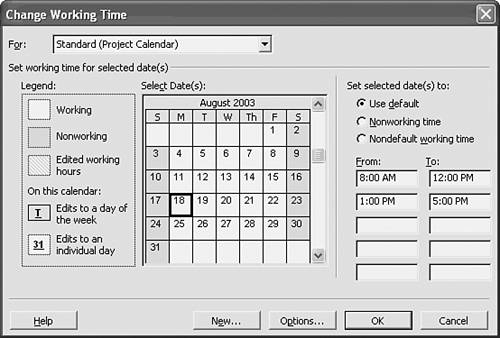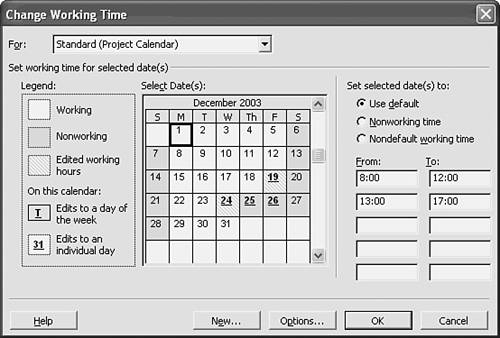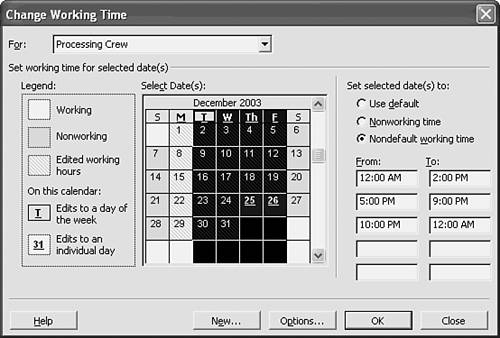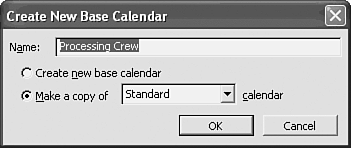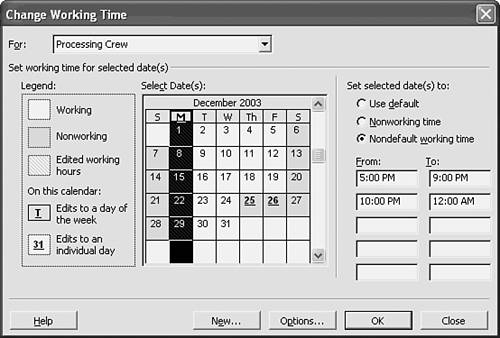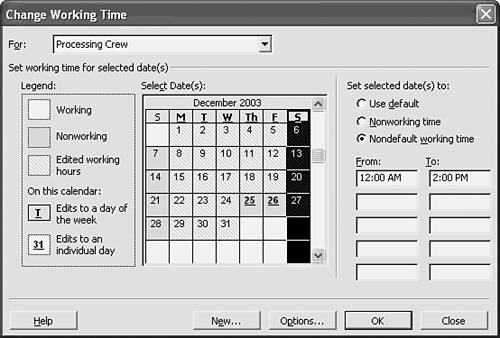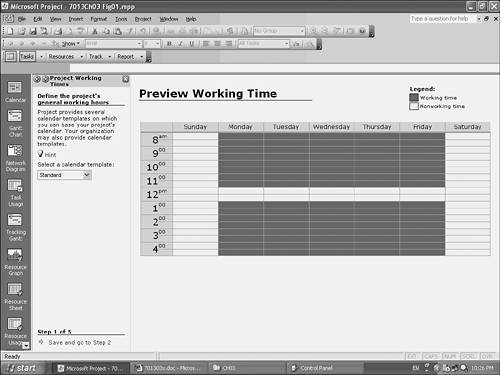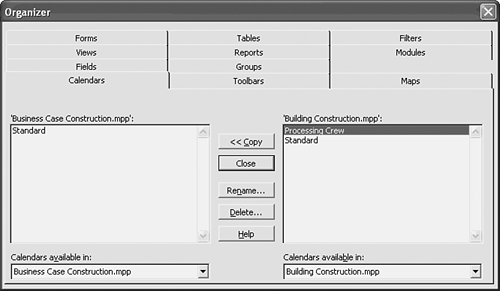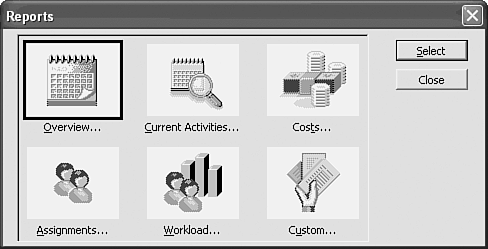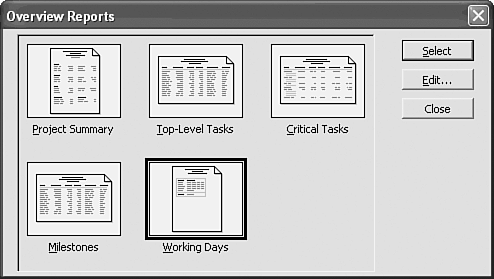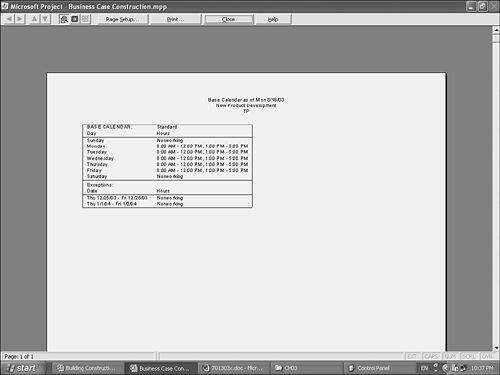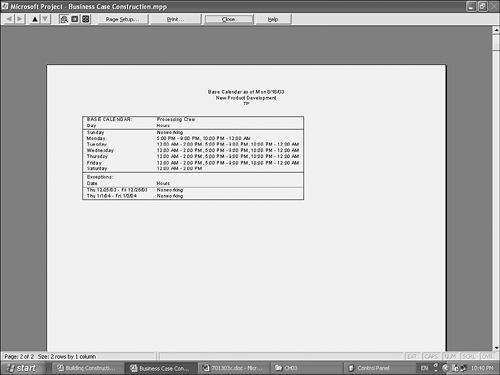Defining a Calendar of Working Time
| < Day Day Up > |
| Microsoft Project uses a calendar, called the base calendar, to define the default working and nonworking days used for scheduling tasks in projects. Three base calendars are built in to Microsoft Project 2003:
All projects are assigned to a base calendar, and the default assignment is to the Standard base calendar. You can edit the Standard calendar, use one of the other built-in calendars, or create additional base calendars and assign a project to one of them if you want. The Standard calendar assumes 5 working days per week, Monday through Friday, with 8 hours of work per day (including an hour off for lunch ). The default schedule is 8:00 a.m. to 12:00 p.m. and 1:00 p.m. to 5:00 p.m. No designated holidays are set in the original Standard calendar. You can edit the Standard calendar to reflect your organization's regular working and nonworking days and hours. You can also designate the exceptions to the normal workdays, such as holidays, or time periods when the organization will be closed for remodeling, a companywide meeting time when no work should be scheduled, and so on. Base calendars are also used as the basis for resource calendars. Each resource has its own calendar, and the resource calendar is linked to a designated base calendar (by default the Standard calendar). The resource calendar inherits all the working days and hours of its base calendar, as well as all the holidays and other exceptions in its base calendar. The resource calendar can be edited to record the days and hours when the availability of the resource differs from the normal working times found in the base calendar. Examples of resource exceptions are vacation days, sick leave, and unusual hours on particular days. For example, the base calendar for an organization in the United States might show that Thanksgiving Day, the third Thursday in November, is a company holiday. Suppose a security guard is scheduled to work on Thanksgiving Day and to have the following Friday off. The resource calendar for this worker would initially show the company holiday, Thanksgiving Day, as a nonworking day and the next Friday as a working day. For this security guard only, the resource calendar needs to be edited to reverse the status of both days. If a resource has only a few exceptions to the Standard calendar, it's easy to edit the resource calendar. If the resource has working times that are radically different from the standard working times, the editing job can require a lot of work. If there are several resources with the same unique set of working times, it's easier to create an additional base calendar that has those unique working times and link each unique resource to that custom base calendar. For example, night and weekend security guards have unique days and hours. Instead of greatly altering a number of individual resource calendars, it's easier to create a Security Guard base calendar to reflect the special working times for security guards . Then, you can link each security guard to that base calendar.
Scheduling with CalendarsProject uses the base calendar for an overall project and the resource calendars to schedule the start dates for tasks. When Project schedules a task, it notes the earliest possible starting date, based on when the predecessors to the task will be completed. If no resources are assigned to work on a task, the project's base calendar is used to schedule the start and finish of the task. Otherwise , Microsoft Project 2003 checks to see what resources are assigned to work on the task and when the resource calendars for these resources show them being available for work. The task is then scheduled to start on the next available working hour for the assigned resources. NOTE The resource calendars take precedence over the project's base calendar. In the absence of a resource calendar, the task is scheduled using the project base calendar. To select a base calendar, choose Project, Project Information. Click the Calendar drop-down list and choose one of the calendarsStandard, 24 Hour, and Night Shiftfrom the list. Editing the Standard CalendarChanging the working days and hours on the Standard calendar affects the scheduled work time for all tasks that have no resources assigned to them and for all tasks whose resources are linked to the Standard base calendar. Changing Working and Nonworking DaysThe original Standard calendar shows all weekdays, Monday through Friday, as working days and all Saturdays and Sundays as nonworking days. You can change the status of any day to make the day working or nonworking, and you can specify the number of hours available for work on any day by defining the starting and ending times for work shifts on that day. To edit the Standard calendar, choose Tools, Change Working Time. The Change Working Time dialog box appears (see Figure 3.16). The Change Working Time dialog box can display a calendar of working and nonworking times for any of the base calendars and resource calendars defined for the project. Figure 3.16. You can use the Change Working Time dialog box to define the days and hours when work can be scheduled by Microsoft Project 2003. The dialog box contains a monthly calendar form, daily working times, buttons to change the calendar, and a legend. The legend indicates how working and nonworking days will be displayed, along with days that have different hours from the default hours. Each date that is modified from the default has the date underlined. If you modify a day of the week for the entire projectfor example, you make the working time on every Monday from 1 p.m. to 5 p.m.the letter M in the Working Time calendar is underlined and in bold. You can use the calendar scrollbar to change months and years . The calendar spans the period from January, 1984, to December, 2049. To change the status of a single day or a consecutive period of days from working to nonworking or vice versa, you click the day with the mouse. You can select consecutive days by clicking and dragging. You can select multiple days that are not consecutive by pressing the Ctrl key as you click the extra dates. On the right side of the dialog box, there are several options in the Set Selected Date(s) To area; you can use these options to change the working or nonworking status of a day. In the Set Selected Date(s) To area of the dialog box, you select the Nonworking Time option button to make the selected day(s) nonworking. To make the selected day(s) working days, you select the Nondefault Working Time option button. TIP To select days by using the keyboard, use the arrow keys to move to the first day you want selected. Hold down the Shift key and use the arrow keys to select additional consecutive days. You can also change the working status of any day of the week for all weeks throughout the year. If your organization works on Saturdays, for example, you will want to make all Saturdays working days. To change the working status of a day for all weeks, you select the day of the week by clicking the day letter at the top of the calendar (for example, S for Saturday). Then, you select the Nondefault Working Time or Nonworking Time option button in the Set Selected Date(s) To area of the dialog box. After the working status of a day of the week is set, that becomes the default status for that day of the week. For example, suppose you have made every Friday, with the hours 8:00 a.m. to 12:00 p.m. (noon), a working day. If you changed a particular Friday to either a full working day or a nonworking day and then wanted to change it back to the default hours for Fridays, you would need to select the Use Default option button to reset the hours from 8 a.m. to 12 p.m. Selecting any specific date and the Use Default option button sets that date's working hours to the default for its day of the week. Figure 3.17 shows the Change Working Time dialog box for the month of December 2003. The company is having a holiday party on Friday, December 19. No work is likely to be accomplished on this project in the afternoon, so this day has been marked as a partial working day. Because the company gives all its employees the afternoon of December 24 as well as all of December 25 and 26 to celebrate Christmas, these days are marked as nonworking days. Partial working days are marked with slash marks; full nonworking days are marked in gray. Figure 3.17. You use the Change Working Time dialog box to define the days and hours when work can be scheduled by Microsoft Project 2003. Changing the Standard Working HoursYou can define the work periods for each day by supplying up to five work periods in the From and To text boxes of the Change Working Time dialog box. The default 8-hour work time periods each day are 8:00 a.m. to 12:00 p.m. and 1:00 p.m. to 5:00 p.m. Most of the time only the first four boxes (under From: and To:) are used. The remaining six boxes are typically filled in when the working times go across midnight, to account for several breaks or meal times, or for some other unusual work schedule. The section "Creating a New Calendar," later in this chapter provides a good example of using the six time boxes. To change the working hours in the Change Working Times dialog box, follow these steps:
NOTE Project checks all time entries for consistency. Each successive time must be later in the day than the time in the preceding time text box. You cannot leave a work period blank and put data in a work period beneath it. Therefore, you must use the top pair of From and To text boxes first; then you can fill in the next pair. Entering Time FormatsYou can use several formats for entering times in the text boxes of the Change Working Time dialog box. You can use either the 12-hour clock or the 24-hour clock to enter times. If you enter times based on the 12-hour clock, make sure that you use the a.m. and p.m. suffixes to ensure that the program understands your intent. If you enter a time without using an a.m. or p.m. suffix, Project uses the first instance of the time following 8:00 a.m. (or whatever time you designate as the Default Start Time on the Calendar tab of the Options dialog box). For example, if you enter 3:30 without a suffix, Project assumes that you want to use 3:30 in the afternoon and attaches the p.m. suffix. If you wanted to set a work shift to start at 5:00 in the morning, you would need to enter 5 am instead of 5:00 because the program interprets 5:00 to mean 5:00 p.m. (If the time you want to enter is on the hour, you can simply enter the hour number.) NOTE You enter noon as 12:00 pm and midnight as 12:00 am . Clearing the Working Hours Text BoxesTo remove a work period from the working hours text boxes in the Change Working Time dialog box, you need to delete both the From time and the To time for that period. To do so, follow these steps:
Resetting a CalendarYou can select the Use Default option button in the Set Selected Date(s) To area of the Change Working Time dialog box to cancel changes you have made for calendar days. Selecting individual days and choosing Use Default returns those days to the original working hours for those days of the week (as defined in the base calendar). Selecting the day of the week letters at the top of the calendar and choosing Use Default returns all days in the selected column to the standard 8-hour day, 8 a.m. to 5 p.m. (or whatever timeframes you have designated for the calendar). Selecting all the weekday letters at the top of the calendar and choosing Use Default returns the working hoursas well as any other exceptionsback to the default of the currently selected calendar. A warning message appears, indicating that the calendar will be reset to the original settings. Creating a New CalendarSuppose you have a processing crew that works from 5:00 p.m. to 2:00 a.m., Monday through Friday. You can create a Processing Crew calendar to use as a base calendar for the resources in that group . On this calendar, the regular shift begins at 5:00 p.m. and continues to 2:00 a.m. the following day. An hour break is scheduled from 9:00 p.m. to 10:00 p.m. Say that on Monday the crew starts at 5 p.m., breaks for dinner at 9 p.m., comes back to work at 10 p.m., and finishes the day at 12 a.m. (midnight). The work from midnight to 2 a.m. is entered on Tuesday. Tuesday through Friday the working times would show 12 a.m. to 2 a.m., then 5 p.m. to 9 p.m., and 10 p.m. to 12 a.m. Saturday would reflect the last hours (12 a.m. to 2 a.m.) of Friday night's shift. (Figure 3.21, later in this chapter, illustrates this example.) Figure 3.21. You can select several days by highlighting the letters for the days at the top of calendar display. You can create a new base calendar for this group by following these steps:
Saving or Canceling Calendar ChangesTo finish editing base calendars and save the changes you have made, click the OK button at the bottom of the Change Working Time dialog box. When you save the calendar, all the calendar information is saved along with the task and resource information in the project document. Clicking the Cancel button causes Project to ignore all the changes you have made. Working with CalendarsIf you create a base calendar in one project and want to use the same base calendar in future projects, you can use the Organizer to copy the calendar to the Global template ( GLOBAL.MPT ). The calendars in the GLOBAL.MPT file are automatically included in any new project file. You can also use the Organizer to copy a calendar to another existing project file, to delete a calendar from the active file, and to rename a calendar in the active file. The following section describes how to access the New Project Wizard and how to use it. NOTE The GLOBAL.MPT file is stored in the directory with the Microsoft Project 2003 program files, which is usually C:\Program Files\Microsoft Office\Office11\1033 . Using the New Project WizardA great feature of Microsoft Project 2003 is the New Project Wizard, which steps you through the process of creating a new project plan. It also enforces the correct use of Enterprise custom fields, encourages collaboration, and provides opportunities to attach supporting documentation to a project. There are two ways to access the wizard:
NOTE If the Goal Based User Interface is not on, the New from Wizard option does not appear in the sidepane. The following steps describe the dialog boxes that take you through the wizard:
You can programmatically modify the New Project Wizard to enforce the best practices in attaching required documents, which might include many of the ones described in step 4. Using the New Calendar WizardThe New Calendar Wizard gives you a single, convenient place to set up calendars and options that affect a project (see Figure 3.23). Figure 3.23. The New Calendar Wizard steps you through the process of defining the working times for a project. You access this wizard via the Goal-Based User Interface by selecting Tasks and then selecting Define Project's General Working Hours. When you run the wizard, you work a series of steps. The following steps describe the dialog boxes that appear in sequence:
Using the Define Working Times for Resources WizardProject provides the Define Working Times for Resources Wizard for setting resource calendars. You access this wizard by clicking Resources from the Project Guide toolbar and then selecting Resource Calendars. You are then walked through how to set resource calendars by proceeding through a series of steps. The following steps describe the dialog boxes in the wizard:
Working with the OrganizerYou can use the Organizer to copy items (such as calendars) from one project or template to another. You can also use the Organizer to delete or rename a calendar. If you copy a calendar to the GLOBAL.MPT file, the calendar becomes part of all newly created project documents. For example, to customize the Standard calendar for all new projects, you follow these basic steps:
You can use the Organizer to manage not only calendars but also other customized items (such as views, reports , macros, forms, tables, filters, toolbars , and menu bars). Therefore, you can activate the Organizer from several points in Project. Probably the most convenient way to access the Organizer is by choosing Tools, Organizer. NOTE You can also access the Organizer through several other dialog boxes, such as those you access by choosing the following options:
Copying Calendars to the Global TemplateYou can access the Organizer through the Tools menu. The active filethat is, the file that contains the calendaris referred to as the source file . The file in which you would like to place a copy of the calendar is referred to as the target file . Follow these steps to copy a calendar to the GLOBAL.MPT file:
NOTE You cannot directly edit the calendars in the GLOBAL.MPT file. To edit a calendar in the GLOBAL.MPT file, copy it to a project file by using the Organizer. Edit the calendar in the project file, and then use the Organizer to copy it back to the GLOBAL.MPT file. Copying a Calendar from One Project to AnotherYou also use the Organizer to copy a calendar from one project document to another. For example, if you want to place a copy of the Processing Crew calendar from the Building Construction file in the Business Case Construction file, follow these steps:
Printing the Base CalendarsYou can print a report to show the details of each of the base calendars in the active project file. Printing reports is covered in detail in Chapter 13 and Chapter 22, "Using and Customizing the Standard Reports." This section is a quick reference on how to print the Working Days report, a report that provides information about the working and nonworking days in all your base calendars. To print the Working Days report, follow these steps:
The report shows the standard working hours for each day of the week, followed by a list of the exceptions for individual days. Each base calendar prints on a separate page. Figure 3.30 is an illustration of the report for the Processing Crew base calendar. Holidays are listed as exceptions below the standard days and hours. Figure 3.30. The Working Days report for the Processing Crew base calendar shows the standard working times plus the exceptions (such as holidays). |
| < Day Day Up > |
EAN: 2147483647
Pages: 283
 To learn more about adjusting calendars to reflect the available resources,
To learn more about adjusting calendars to reflect the available resources, 